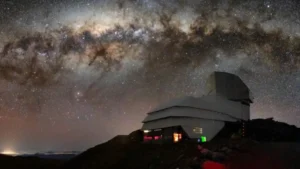Jupiter’s largest moon, Ganymede, is only a quarter of Earth’s diameter. But the gas giant’s cupbearer has a vast ocean lurking beneath its surface — an ocean comprised of more than twice the amount of water on Earth. Scientists have long held that if life is to be found anywhere else in our solar system, it’s there. And soon enough, they might have (some) of their answers.
That’s because the European Space Agency (ESA) is in the final testing phase of its Jupiter Icy Moons Explorer (Juice) mission. The unmanned craft will launch from Europe’s Spaceport in French Guiana on April 13, 2023, propelled into space by the Ariana 5 rocket.
Its mission? Take a closer peak at Ganymede than ever before.
“This mission is just incredible,” ESA project scientist Olivier Witasse told The Guardian. According to the outlet, Juice is packing the most sophisticated scientific instruments ever to venture off the planet.
That’s because it will have to study an environment that will be uniquely disruptive to its sensitive equipment.
Ganymede’s oceans generate a magnetic field, making it the only moon in our solar system to do so. That’s great for showy Ganymede, but it makes the team hoping to study it a little sweaty. The magnetic signals can and will interfere with Juice’s sensitive instruments, clouding the salinity, depth, and other ocean-related information the team hopes to collect.
The information will bring us one step closer to understanding if Jupiter’s moons can indeed support life.
“It is terrifying what we are trying to do,” principal investigator Michele Dougherty, Imperial College, London, candidly shared with The Guardian. “Detecting those tiny signals is what keeps me awake at 2 am. It’s like finding needles in a haystack.”

Juice being unpacked at Europe’s Spaceport in French Guiana. Juice will carry the most sensitive instruments yet out into the solar system. Photo: ESA
The solution is to get Juice up close and personal, where her instruments can overcome the interference. The craft will orbit 500km above Ganymede’s surface for a year. If all goes well (and if there’s fuel to spare), the ESA will extend the mission and lower Juice to 177km for even better readings. But don’t hold your breath — Juice won’t reach its destination until 2034. And even then, Dougherty stressed, it will take a while to puzzle out the results.
“We’re not going to solve this on our first flyby of Ganymede,” he said. “Only at the end of the mission will we have enough data to separate everything out.”
Sharing the heavens around Jupiter will be NASA’s Europa Clipper craft, arriving in 2030. Europa native radiation is much more likely to fry electronics. To stay whole, the Europa Clipper will zip in and out of Europa’s orbit over three-and-a-half years.
Together, the two missions will help Earth-bound scientists continue unraveling one of humanity’s most intriguing puzzles — how to inhabit other worlds.






